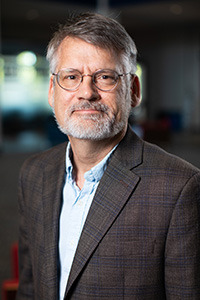Courses Taught
- EDUC 201: Introduction to Education and Classroom Technology
- EDUC 350: Behavior and Individual Differences
- EDUC415: Diagnostic Measurement and Evaluation
- EDUC476: Student Teaching I
- EDUC 701: Theories and Research in Educational Learning
- EDUC 812: Advanced Educational Statistics
- EDUC 815: Quantitative Methods of Research
- EDUC 915: Advanced Quantitative Methods of Research
- EDUC 919: Professional Writing and Research
- EDUC 989: Dissertation and Proposal Research
- EDUC 980: Dissertation Prospectus
- CRFT 101: Introduction to Craft Skills
Professional Memberships
- International Technology and Engineering Educators Association (ITEEA)
- Virginia Academy of Science (VAS)
Biography
Kurt Michael serves as a full-time faculty member at Liberty University. He began his career in Fairfax County Virginia as a public school teacher with a focus on technology education. He has since worked at Virginia Tech, Clemson University, and the Shenandoah Valley Governor’s School for Math, Science, and Technology. Today, Dr. Michael enjoys conducting research with students and teaching classes.
Publications
- Claxton, B. & Michael, K.Y. (2021). Conducting applied research in education (2nd ed.). Dubuque, IA: Kendall Hunt Publishers.
- Lunde, R., Michael, K.Y., Watson, S., & Paynter, K. (2019). Predicting dissertation methodology choice among doctoral candidates at a faith-based university. VA Journal of Science 70(1), 1-21.
- Michael, K.Y., Jones, A.J., & Lawrence, C. (2018). The technology of paint: Making paint in the elementary school classroom, The Elementary STEM Journal 23(1), 7-10.
- Michael, K.Y. (2017). Freehand sketching for young engineers. Children’s Technology and Engineering: A Journal for Elementary School Technology and Engineering Education, 21(3), 15-17.
- Michael, K.Y. & Alsup, P.R. (2016). Differences between the sexes among Protestant Christian middle school students and their attitudes toward science, technology, engineering and math (STEM), Journal of Research on Christian Education 25(2), 147-168.
- Michael, K.Y. & Jones, A.J. (2015). Vinyl Records: Going Retro in the Elementary School Classroom. Children’s Technology and Engineering: A Journal for Elementary School Technology and Engineering Education, 20(2), 30-33.
- Michael, K.Y. & Jones, A.J. (2015). Humorous faces in technology. Children’s Technology and Engineering: A Journal for Elementary School Technology and Engineering Education, 19(4), 12- 15.
- Michael, K.Y. (2015). The mysteries of Mars: Exploring the surface. Children’s Technology and Engineering: A Journal for Elementary School Technology and Engineering Education, 19(3), 14-17.
- Michael, K. Y. (2015, Spring). Women of faith in science: The double glass ceiling. The Journal of Mathematics and Science: Collaborative Explorations, 15, 95-100.
- Michael, K.Y. (2014). Creative techniques for young inventors. Children Technology and Engineering: A Journal for Elementary School Technology and Engineering Education, 19(1), 22-25.
- Michael, K.Y. (2013, September). Bathymetry in the classroom. Journal of Technology and Engineering Teacher, 73(14), 14-17.
- Michael, K.Y. (2009). The effect of a computer simulation activity versus a hands-on activity on product creativity in technology education. In J.R. Fraenkel & N.E. Wallen, How to design and evaluate research in education (7th ed., pp. 282-292). New York, NY: McGraw-Hill.
- Michael, K.Y. (2007). The effect of a computer simulation activity versus a hands-on activity on product creativity in technology education. In L.S. Lyne, A cross section of educational research (5th ed., pp. 71-78). Los Angeles, CA: Pyrczak Publishing.
- Michael, K.Y. & Tufts, L. (2003, May). Blast off to Mars using a computer simulator. Technology and Children: A Journal for Elementary School Technology and Engineering Education, 7(4), 10.
- Michael, K.Y. & Easley, B. (2002, Sept). Magnetic levitation racers. Technology and Children: A Journal for Elementary School Technology and Engineering Education, 7(1), 18-19.
- Michael, K.Y. & Linnel, C. (2002). The effectiveness of an interactive problem-solving computer simulation game on enhancing the creativity of Clemson University education majors, The Clemson Kappan, 7(1), 24-31.
- Michael, K.Y. & Roberts, A. (2002). Big machines at work. Technology and Children: A Journal for Elementary School Technology and Engineering Education, 6(4), 30-32.
- Michael, K.Y. (2001, Nov). Technology educations students make a difference through service learning. Technology and Engineering Teacher, 61(3), 30-32.
- Michael, K.Y. (2001). The effect of a computer simulation activity versus a hands-on activity on product creativity in technology education. Journal of Technology Education, 13(1), 31-43.
- Michael, K.Y. (2000). Are computer simulations as effective as hands-on experiences in the classroom? The Clemson Kappan.
- Michael, K.Y. (2000). The effectiveness of computer simulation technology on enhancing the creativity of products produced by seventh grade technology education students (Doctoral Dissertation, Virginia Polytechnic Institute and State University).
- Michael, K.Y. (1998). Computer simulation games teach technology concepts. VTEA Technologize, 1, 10.
- Carnes, M. & Michael, K.Y. (1996). How-to plan for teaching writing in tech ed. Tech Directions, 56(5), 20.
- Michael, K.Y. (1995). Ergonomics for the CAD lab. Tech Directions, 55(4), 6-18.
Research Interests
- STEM Education
- Technology Education
- Creativity
